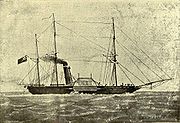
Screw frigate
Encyclopedia

Frigate
A frigate is any of several types of warship, the term having been used for ships of various sizes and roles over the last few centuries.In the 17th century, the term was used for any warship built for speed and maneuverability, the description often used being "frigate-built"...
s and the smaller steam corvette
Corvette
A corvette is a small, maneuverable, lightly armed warship, originally smaller than a frigate and larger than a coastal patrol craft or fast attack craft , although many recent designs resemble frigates in size and role...
s were steam-powered warships.
The first vessel that can be considered a steam frigate was the Demologos
Demologos
Demologos was the first warship to be propelled by a steam engine. She was a wooden floating battery built to defend New York Harbor from the Royal Navy during the War of 1812. The vessel was designed to a unique pattern by Robert Fulton, and was renamed Fulton after his death...
which was launched in 1815 for the United States Navy
United States Navy
The United States Navy is the naval warfare service branch of the United States Armed Forces and one of the seven uniformed services of the United States. The U.S. Navy is the largest in the world; its battle fleet tonnage is greater than that of the next 13 largest navies combined. The U.S...
.
By the 1830s many navies were experimenting with steam-powered warships. This first generation of steam warships, termed 'paddle frigates', used paddlewheel
Paddle steamer
A paddle steamer is a steamship or riverboat, powered by a steam engine, using paddle wheels to propel it through the water. In antiquity, Paddle wheelers followed the development of poles, oars and sails, where the first uses were wheelers driven by animals or humans...
s mounted on either the sides or in the center. The ships were equipped with large guns mounted on one deck. Paddlewheels were less efficient than the propellers and more vulnerable to damage, and in the 1850s navies converted over to propellers.

The ships retained a full sail-plan
Sail-plan
A sail-plan is a set of drawings, usually prepared by a naval architect. It shows the various combinations of sail proposed for a sailing ship.The combinations shown in a sail-plan almost always include three configurations:...
however, partly due to conservatism, and partly to conserve coal
Coal
Coal is a combustible black or brownish-black sedimentary rock usually occurring in rock strata in layers or veins called coal beds or coal seams. The harder forms, such as anthracite coal, can be regarded as metamorphic rock because of later exposure to elevated temperature and pressure...
, the last being an especially important consideration for frigates, which often operated independently on the far side of the world. These 'screw frigates', built first of wood and later of iron
Wrought iron
thumb|The [[Eiffel tower]] is constructed from [[puddle iron]], a form of wrought ironWrought iron is an iron alloy with a very low carbon...
, continued to perform the traditional role of the frigate until late in the 19th century. France and the United Kingdom were the only two countries to develop fleets of wooden steam screw battleship
Battleship
A battleship is a large armored warship with a main battery consisting of heavy caliber guns. Battleships were larger, better armed and armored than cruisers and destroyers. As the largest armed ships in a fleet, battleships were used to attain command of the sea and represented the apex of a...
s, and both navies built numbers of screw frigates.
From 1859, armour was added to ships based on existing frigate and ship of the line
Ship of the line
A ship of the line was a type of naval warship constructed from the 17th through the mid-19th century to take part in the naval tactic known as the line of battle, in which two columns of opposing warships would manoeuvre to bring the greatest weight of broadside guns to bear...
designs. The additional weight of the armour on these first ironclad warship
Ironclad warship
An ironclad was a steam-propelled warship in the early part of the second half of the 19th century, protected by iron or steel armor plates. The ironclad was developed as a result of the vulnerability of wooden warships to explosive or incendiary shells. The first ironclad battleship, La Gloire,...
s meant that they could have only one gun deck, and they were technically frigates, even though they were more powerful than existing ships-of-the-line and occupied the same strategic role. The phrase 'armoured frigate' remained in use for some time to denote a sail-equipped, broadside-firing type of ironclad. For a time was the most powerful type of vessel afloat.
Towards the end of the 19th century, the term 'frigate' fell out of use. Armoured vessels were designated as either 'battleship
Battleship
A battleship is a large armored warship with a main battery consisting of heavy caliber guns. Battleships were larger, better armed and armored than cruisers and destroyers. As the largest armed ships in a fleet, battleships were used to attain command of the sea and represented the apex of a...
s' or 'armoured cruisers', while unarmoured vessels including frigates and sloops were classified as 'unprotected cruisers'.
The only surviving screw frigate is the Danish
Denmark
Denmark is a Scandinavian country in Northern Europe. The countries of Denmark and Greenland, as well as the Faroe Islands, constitute the Kingdom of Denmark . It is the southernmost of the Nordic countries, southwest of Sweden and south of Norway, and bordered to the south by Germany. Denmark...
Jylland
Jylland (ship)
Jylland is the world's last screw-propelled steam frigate. During the Second War of Schleswig in 1864, it participated in the naval action against the Austrian-Prussian fleet in the Battle of Heligoland on 9 May 1864...
.

